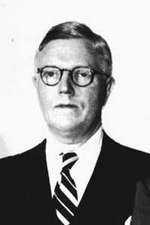

Theodore Lightner
Theodore Lightner invented the idea of doubling a slam to ask for an unusual lead. "Unusual" typically means one of two things:
The doubler expects that without alerting his partner to the need for a special lead, the slam will make. Lightner doubles are not alertable.
Say you are on lead after this auction:
| YOU | North | East | South |
|---|---|---|---|
1 |
Pass | 1 |
|
| Pass | 3 |
Pass | 4NT |
| Pass | 5 |
Pass | 6 |
| Pass | Pass | Dbl | All Pass |
You hold:  5
5  Q J 7
Q J 7 Q 2
Q 2 10 8 7 6 5 3 2
10 8 7 6 5 3 2
. Likely, partner has a club void, so a club lead is indicated. (It isn't likely a diamond lead is needed based on your hand and the auction).
Lightner doubles do carry a bit of risk. On this example, partner had better be sure that 6NT will not make, since the opponents might run there.
While Lightner was originally intended for use against slam, a similar double exists at lower levels. On an auction like 1NT--Pass--3NT--Pass--Pass--Dbl, double doesn't mean "we're beating this". It asks for a lead of the shorter major. A good hand for this double:
 KQJ102
KQJ102  82
82  A32
A32  543
543
You suspect partner is about to lead a heart, but a spade lead would likely set 3NT, so double asks for that unusual lead.
If you would like to learn more about Doubles, you'll find them in Larry's book.
Updated: November 2021